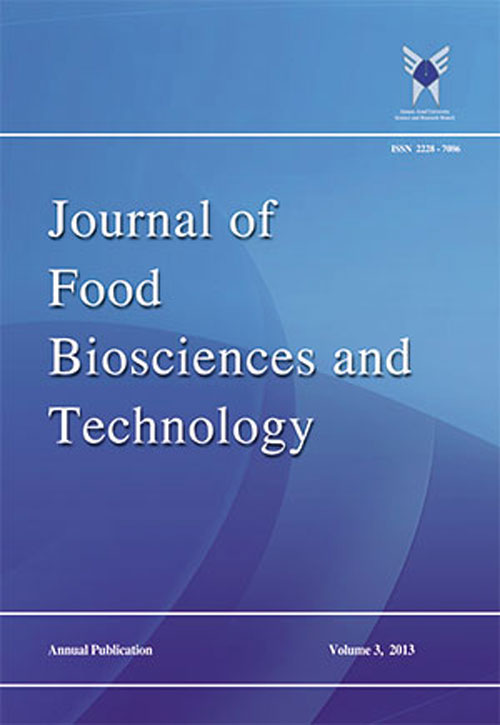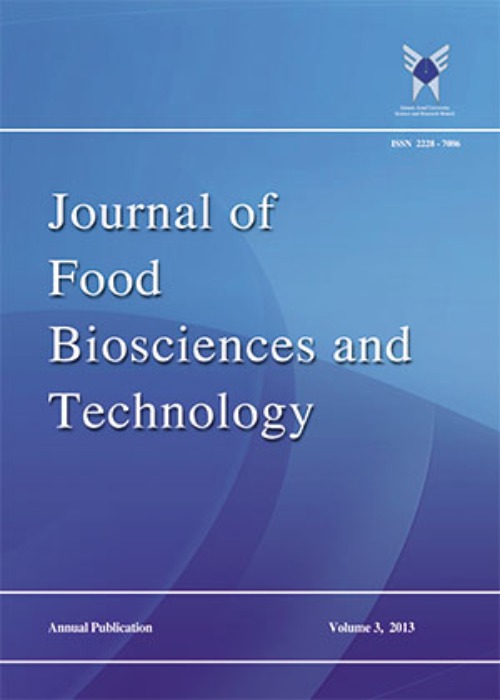فهرست مطالب

Journal of Food Biosciences and Technology
Volume:12 Issue: 1, Winter 2022
- تاریخ انتشار: 1400/09/09
- تعداد عناوین: 6
-
-
Pages 1-10
In this research, two types of whey powder from traditional and UF cheese making were compared for structural components and functional properties. The effect of pH on the functional properties of the two whey powders was evaluated. Foam capacity, foam stability, water holding capacity, and emulsifying activity index were the functional characteristics that were evaluated in different pH values for two whey powder. The whey powder obtained from the traditional cheese-making compared to whey powder by UF cheese-making showed a higher percentage in terms of protein, fat, lactose, and salts, as well as the foam capacity, water holding capacity, and emulsion activity index of whey powder obtained from the traditional cheese-making was significantly (P < 0.05) more than whey powder obtained from UF cheese-making. However, the foam stability of these two powders did not show a significant difference (P > 0.05). This study shows that the higher quality of whey powder produced in the traditional cheese making as compared to whey powder produced by the UF cheese making can compensate for the lower traditional cheese production efficiency compared to UF cheese.
Keywords: Functional Properties, Traditional cheese-making, Ultrafiltration cheese-making, Whey powder -
Pages 11-18
Gelatin is a beneficial component in the structure of various foods such as desserts and pastilles. These products are most popular with children because of their visual appeal and bright colors. In this study, 30 samples of jelly products were collected from the Tehran markets and were tested for the molecular identification of the gelatin source. The gelatin used in the industry is mainly produced from bovine and porcine species. Identification and detection of the species used in the gelatin structure are required from the perspective of consumer confidence in food health safety as well as religious beliefs. A species-specific singleplex PCR reaction targeting 277 bp porcine D-loop regions was used to detect porcine species. It was found that none of the products contained porcine gelatin. Complementary experiments used with 130 bp bovine mitochondrial DNA (mtDNA) to detect bovine species showed that the collected samples, according to the label, contained bovine species DNA. Therefore, this qualitative PCR assay is a useful and effective method for monitoring gelatin species origin in food products and has the ability to identifying the DNA of the porcine in gelatin as a highly processed food product and Halal authentication.
Keywords: Fraud detection, Gelatin, Halal Authentication, Jelly Product, Qualitative PCR, Species Identification -
Pages 19-28
Thyme is widely used in the food and pharmaceutical industry as an antimicrobial and antioxidant aromatic component, mainly due to its essential oil composition especially the presence of Thymol. In this research, the essential oil of Thymus vulgaris collected from Hamedan was obtained by hydro-distillation method. The response surface method was employed to determine the optimal values of the evaluated factors. The proposed optimal conditions were 1.5 to 2.5 hours for 60 to 80 grams of sample per 100 ml. The optimum extraction time of essential oil from the aerial parts and leaves of thyme were 2.5 hours for 77.63 grams and 2.5 hours for 64.66 grams per 100 ml respectively. The results of experiments in optimum conditions showed that the highest amount of Thymol was found in the essential oil obtained from aerial parts of thyme.
Keywords: Essential Oil, Extraction, Thymus vulgaris, Thymol -
Pages 29-38
Marshmallow (Althaea officinalis) belonging to Malvaceae family possesses mucilage containing cells in stem, petiole, petals and seeds showing antimicrobial activity, anti-inflammatory, immunomodulatory effects among others. In this study, in order to determine the characteristics of marshmallow seed mucilage, as a potential new source of hydrocolloid, some instrument methods (Scanning Electron Microscopy, Fourier transform infrared spectroscopy, nuclear magnetic resonance spectroscopy, etc.) were used and viscosity of mucilage was determined. SEM analysis showed that the mucilage had an amorphous structure and disordered particle size. Mucilage solution at pH of 7 had negative charge; zeta potential of -22.4 mV, electrical conductivity of -1.753 mS /cm and particle size being 255.1 d.nm. Its glass transition temperature (Tg) was 37.9 °C and the melting process started at 34.3 °C to 182.2 °C. An endothermal peak was observed at 92.6°C. Heat of infusion was 199.19 J/g. The most important functional groups identified by FTIR were an asymmetric stretching of double-bond (C=0) in the deprotonated carboxylated groups at 14.3 and 1627 cm-1 vibratory stretching ring of pyranose at 1280 cm-1 and 1115 cm-1 as well as glycoside bonds at 617 and 780 cm-1. Marshmallow seed mucilage solution showed a shear–thinning (pseudoplastic) behavior and the most predominant elements found in the mucilage were carbon (26.59%), potassium (26.39%).
Keywords: DSC, Marshmallow, NMR, SEM, Seed Mucilage, Viscosity -
Pages 39-46
The authentication of luxury oils is an important issue. Ghee is a famous traditional dairy product that likely to be adulterated with the other oils and fats specially the hydrogenated vegetable oils. Recently, Fourier transforminfrared (FT-IR) spectroscopy accompanying with chemometric techniques (partial least square) were introduced for validation of different oil quality. In the present study, IR spectra of pure ghee and three partially hydrogenated vegetable oils (soya bean oil, canola and sunflower oils) along with mixtures of different amounts of vegetable oils with ghee (10, 20 and 30%) were investigated. Partial Least Squares (PLS) model correlates the actual and FT-IR predicted values of oil adulterants where coefficients of determination (R2) were 0.986, 0.997 and 0.991 for soya bean oil, canola oil and sunflower, respectively. The resulted RMS%RE values of soya bean oil, canola and sunflower oils are 0.94% and 1.192 and 2.54%, respectively. The method could be a rapid and precise alternative for identification of adulterated ghee.
Keywords: Adulteration, Fourier Transformed Infrared, Ghee, Vegetable Oils -
Pages 47-61
There are a number of fruit drying methods and hot air flow drying has been considered the most common one. However, it is not an economical way due to the huge amount of energy consumption. Using ultrasound waves as a pre-treatment in drying may rise drying efficiency as well as alleviating the cost level. In this research, drying of sour cherry has been accomplished, applying ultrasound waves as a pre-treatment. In this case, the effects of ultrasound parameters i.e., sonication temperature, power intensity, and sonication time are discussed. The preliminary results illustrate the role of ultrasound waves as a pre-treatment, in which the drying time is already reduced from 7 hours to 3 hours; on the other hand, the maximum water loss has been achieved with sonication temperature of 30⁰C, power intensity of 147 w/cm2 and sonication time of 60 min. Moreover, the amount of moisture loss is surged through increasing the ultrasound exposing time, as compared to a conventional sample. It is worth mentioning that among these mentioned parameters, the temperature plays the most significant role on the water loss. Consequently, using ultrasound waves is a promising way for reducing the temperature, time and energy in hot air flow drying process.
Keywords: Sour Cherry, Ultrasound-Assisted Drying, Sonication Parameters, Textural Properties


